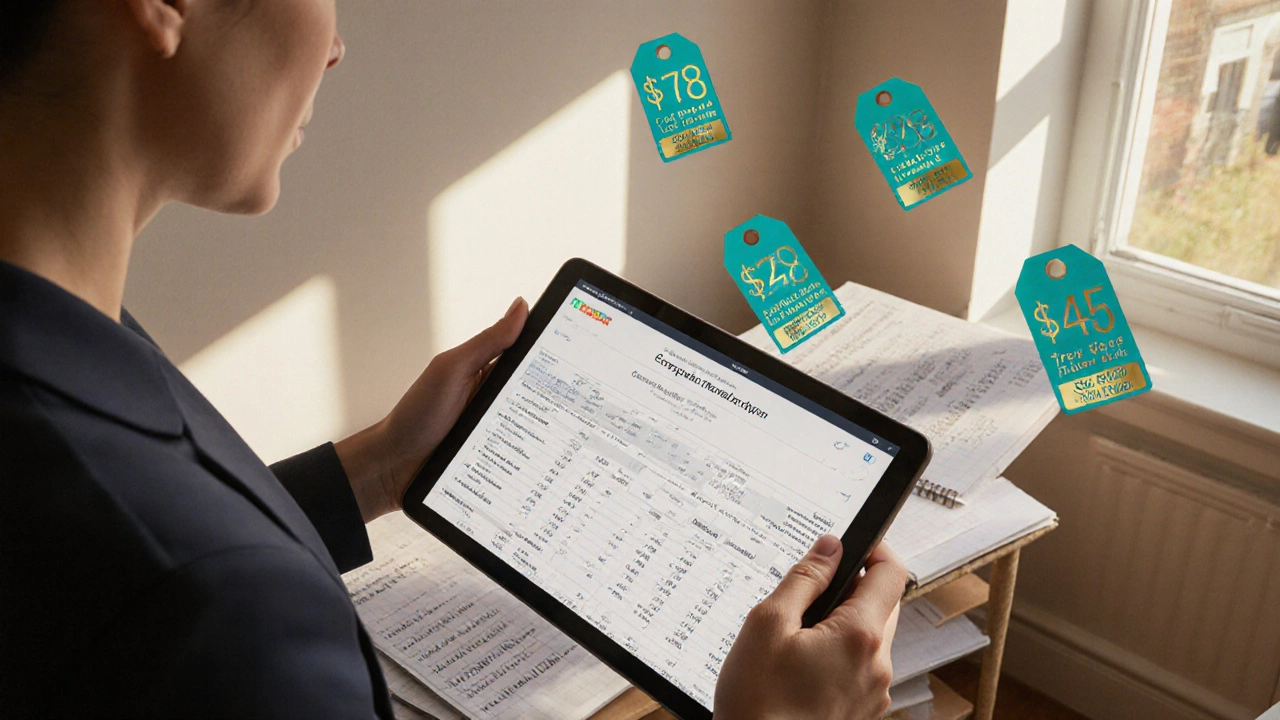Rental Yield Calculator
Calculate Your Investment Profitability
See how much your property generates in income compared to its value. Based on real estate agent calculations.
Investment Analysis
Real estate isn’t just about showing houses and shaking hands. Behind every sale, rental, or offer is a stack of numbers that decide who wins, who loses, and how much everyone makes. If you think math is just something you struggled with in school, think again. Real estate agents use math every single day - and getting it wrong can cost thousands.
Calculating Property Values
One of the most common tasks for an agent is figuring out what a home is worth. This isn’t guesswork. It’s called a Comparative Market Analysis (CMA), and it’s pure math. You take three to five recently sold homes in the same neighborhood that are similar in size, age, and condition. Then you adjust for differences. If the comparable home had a garage and yours doesn’t, you subtract £15,000. If your house has a renovated kitchen and theirs doesn’t, you add £20,000. These adjustments aren’t random. They’re based on local data from the Land Registry and past sales trends.
For example, in South London, a 3-bedroom semi-detached house with a garden sells for an average of £580,000. If a similar house has a double garage, it might sell for £610,000. That £30,000 difference isn’t magic - it’s what buyers are actually paying for that feature. Agents track these patterns over time. A house that sold for £550,000 in January might go for £575,000 in October because interest rates dropped and demand rose. Math turns opinion into evidence.
Commission and Compensation
Most agents work on commission - usually 1.5% to 2% of the sale price in the UK. That means if you sell a £400,000 home, your gross commission is £6,000 to £8,000. But that’s not what you take home. You split it with your agency, pay taxes, cover marketing costs, and sometimes share with a co-agent. So you need to calculate your net earnings fast.
Let’s say you sell a £650,000 property. Your agency takes 40% of the commission, and you pay 20% in taxes and expenses. Here’s the breakdown:
- Sale price: £650,000
- Commission rate: 1.8% = £11,700
- Agency share (40%): £4,680
- Your share before tax: £7,020
- Taxes and expenses (20% of your share): £1,404
- Net take-home: £5,616
That’s why agents don’t just chase big sales. They calculate the return on time. A £300,000 home that sells in 12 days might be more profitable than a £900,000 one that sits for six months. Math helps you decide where to focus.
Mortgage and Affordability Calculations
Buyers don’t just ask, “Can I afford this?” They ask, “How much can I borrow?” And that’s where math gets critical. Lenders use a formula called the debt-to-income ratio. In the UK, most banks cap this at 4.5 times your annual income. So if you earn £50,000 a year, you might qualify for a £225,000 mortgage.
But that’s just the start. You also need to factor in monthly payments. A £225,000 mortgage at 4.5% interest over 25 years equals £1,238 per month. Add council tax (£150), utilities (£120), and insurance (£30), and you’re at £1,538. If the buyer’s monthly take-home pay is £3,000, they’re spending over half their income on housing. That’s risky. A good agent doesn’t just show houses - they show the math behind the numbers.
Agents also help buyers understand how much they can afford after a deposit. If a buyer has £40,000 saved and wants to buy a £300,000 home, they need a £260,000 mortgage. But if the bank only lends 85% of the value, they’ll need £45,000 down. Suddenly, their £40,000 isn’t enough. Math exposes the gap before the buyer gets their heart broken.

Rental Yield and Investment Analysis
Investors don’t buy property because they like the curtains. They buy because of the return. The key metric? Rental yield. That’s the annual rent divided by the property value, times 100.
Example: A flat in Peckham rents for £1,800 a month. That’s £21,600 a year. The purchase price was £360,000.
Rental yield = (£21,600 / £360,000) × 100 = 6%
That’s a strong yield in London. But agents don’t stop there. They subtract expenses: letting agent fees (10% of rent = £1,800), maintenance (£800), void periods (2 months = £3,600), and insurance (£300). Net income = £21,600 - £6,500 = £15,100. Net yield = 4.2%.
Now compare that to a £200,000 property in Manchester renting for £1,000/month. Gross yield = 6%. Net yield after expenses = 5.1%. Suddenly, Manchester looks better - even though the London property feels more prestigious. Math cuts through emotion.
Capital Gains and Tax Planning
When someone sells a property they’ve owned for years, they might owe Capital Gains Tax. The calculation is simple: sale price minus purchase price minus allowable costs. But the details matter.
Let’s say you bought a house in 2018 for £320,000. You spent £25,000 on renovations. You sell in 2025 for £450,000. Your gain is £450,000 - £320,000 - £25,000 = £105,000. The first £12,300 (2025 allowance) is tax-free. The rest - £92,700 - is taxed at 18% or 28%, depending on your income. That’s £16,686 in tax. An agent who doesn’t run these numbers could set a price that leaves the seller with less than expected.
Some agents also help clients use tax reliefs. If the property was their main home for part of the ownership, they might qualify for Private Residence Relief. That can wipe out the entire gain. But you need to calculate the exact number of months lived there versus rented out. One wrong digit, and the client pays thousands more.

Discounts, Incentives, and Negotiation Math
Buyers often ask for concessions: “Can you pay my legal fees?” or “Can you include the furniture?” These aren’t just perks - they’re financial moves. An agent must calculate their true cost.
Example: A buyer wants the seller to pay £3,000 in legal fees and include £5,000 worth of furniture. The seller’s asking price is £420,000. If the seller agrees, the net proceeds drop to £412,000. But the buyer might have offered £415,000 without those extras. So the seller gave away £8,000 in value just to make the buyer feel good. That’s a loss.
Smart agents reframe it: “If you reduce your offer by £5,000, I’ll leave the kitchen appliances.” Now the seller keeps more cash, and the buyer gets what they want. Math turns emotional asks into fair trades.
Open House Attendance and Conversion Rates
Agents track everything. How many people came to the open house? How many asked for a viewing? How many made an offer? That’s a funnel - and it’s all numbers.
If 40 people tour a house and 8 request a second viewing, that’s a 20% conversion rate. If 2 of those 8 make an offer, that’s a 5% offer rate. Compare that to another property where 30 people toured and 12 requested viewings (40%), but only 1 made an offer (3.3%). The first house is more efficient. The agent knows to push harder on it.
They also track how long it takes from first viewing to offer. If it’s usually 5 days in that area and this one’s taken 12, something’s wrong. Maybe the price is too high. Maybe the photos are bad. Math tells you what to fix.
Why Math Matters More Than Personality
You can be charming, knowledgeable, and always on time - but if you can’t do the math, you’ll lose deals. Buyers notice when you can’t explain why a house is priced the way it is. Sellers notice when you don’t know how much they’ll actually net after fees. Investors notice when you can’t calculate yield accurately.
The best agents aren’t the loudest. They’re the ones who pull out a calculator, show you the numbers, and say, “Here’s what this means for you.” They turn uncertainty into clarity. And in real estate, where emotions run high and money is on the line, that’s the real skill.

